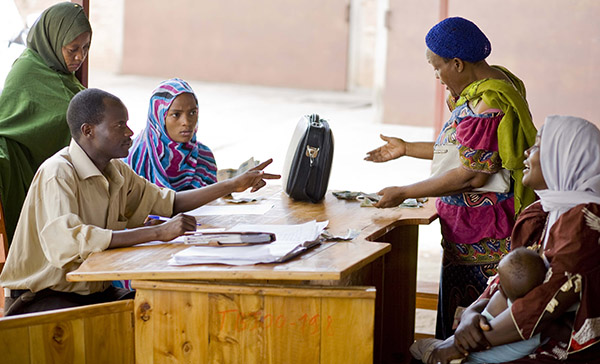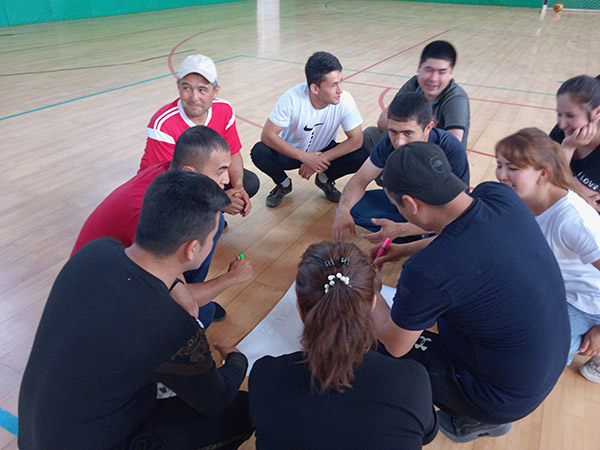In September of this year, e-MFP published the results of a survey that mapped Human Resource Development (HRD) Practices in the Microfinance Sector and highlighted opportunities for acting on those results. This is the first part of the third blog in a series of thematic case studies which explore the actions that some survey participants have taken to address each area. The profiled institutions were selected based on the quality of their HR practices and their willingness to share experiences. We are extremely grateful for their time and effort to contribute to this important research.
 All but one of the case study institutions in this series conduct interviews with employees when they leave the organization. The insights gathered during these interviews have helped the MFIs understand what can be improved, but they haven’t shed much light on what MFIs are doing right. Why do people engage and stay engaged? In the words of Salome Kvakhadze, Head of Talent Development and Management at Crystal in Georgia, “We need to find out what motivates them BEFORE they leave. We want to be more proactive.”
All but one of the case study institutions in this series conduct interviews with employees when they leave the organization. The insights gathered during these interviews have helped the MFIs understand what can be improved, but they haven’t shed much light on what MFIs are doing right. Why do people engage and stay engaged? In the words of Salome Kvakhadze, Head of Talent Development and Management at Crystal in Georgia, “We need to find out what motivates them BEFORE they leave. We want to be more proactive.”
The case study MFIs are using a variety of methods to better understand and influence employee engagement. Among these are climate and satisfaction surveys, focus groups, polls, complaint and suggestion systems, Q&A sessions with the CEO, informal conversations, and personal observation. What follows are their reflections on what works and why.
A clear career growth path
In interviews with the MFIs, a clear and credible career growth path was identified as the most important factor in staff retention. If employees see a way to grow within an organization, they are much more likely to stay than if they don’t. Promotion to a higher level of responsibility and compensation is attractive to most employees, even if it’s a goal that isn’t immediately attainable. What seems to matter is the visibility of the career ladder and the extent to which employees feel it is possible to climb.
At Mutuelle pour le Développement à la Base (MDB) in Benin, the career ladder begins with a three-month internship, at the end of which participants are evaluated and the best performers are offered a six-month, renewable work placement. Additional training is provided and those who pass a subsequent evaluation are offered a longer-term contract when a position becomes available. Espérat Tossa, the Executive Director, explains how the promotion chain continues: “A successful savings collector may be promoted to become a loan officer, the loan officer becomes a branch manager, and so on.” Bank Arvand in Tajikistan follows a similar approach, drawing from a pool of agents who are responsible for client recruitment to fill vacancies in loan officer positions.
The growth path doesn’t have to be constrained to an advancement in position. VisionFund Guatemala, for example, has categories within the loan officer position. Employees can move from the beginner to junior, senior, and master designations and see their salary and responsibility increase. Only after reaching the last category is a loan officer eligible for promotion to branch manager. In the meantime, all loan officers can grow, and all are eligible for variable remuneration based on the growth and quality of their portfolio.
Part of what makes internal promotion effective in the case study institutions is that it’s the norm. Most positions are filled internally, so employees see the career ladder in action and have confidence in its effectiveness. Nancy Camey, People and Culture Manager at VisionFund Guatemala remarked, “They have an example that their boss grows with the organization and the organization grows with him.”
 Any act of promotion sends a message about what the organization values. If employees see that people with certain competencies are being promoted, that will encourage them to develop the same set of competencies. The more consistently the same competencies are promoted, the more naturally those competencies evolve within the organization. Every employee will have examples to learn from.
Any act of promotion sends a message about what the organization values. If employees see that people with certain competencies are being promoted, that will encourage them to develop the same set of competencies. The more consistently the same competencies are promoted, the more naturally those competencies evolve within the organization. Every employee will have examples to learn from.
VisionFund Guatemala has a competency management system that is linked to career paths. It clarifies what competencies are required to excel in a position, so people know what information and skills they need to acquire if they want to advance in a particular direction. Bank Arvand has a similar system of career maps for every position which accomplishes a similar purpose. With this kind of guidance, employees can proactively seek opportunities that help them develop in the direction they desire; they don’t have to wait for the organization to deem them eligible for development.
Of course, growth doesn’t just mean promotion. Lateral career moves, stretch assignments, involvement as a coach or mentor, and participation on a task force, problem solving team, or product/market development team are all growth opportunities that could engage employees.
Link HRD investments to career growth opportunities
The more immediately an employee can use the knowledge or skills acquired in the workplace, the more likely it is that the HRD investment will generate value for the employee and the employer. As time passes, information will be forgotten, skills will get rusty, and motivation often wanes.
Fermin Sanchez, CEO of FINCA Guatemala, believes that this is the main reason for which some MFIs see increased turnover when they invest in employee development. Employees don’t want to waste what they’ve gained any more than institutions do. “If you train someone, if you give them more knowledge, it must be hand in hand with growth, with additional responsibility, or the authority to take decisions. If people aren’t challenged, that's when they start thinking about going to the competition.”
Help employees see the value they’re creating
At Bank Arvand, each position’s job description includes KPIs as well as a definition of its “valuable end product” – the contribution that people in that position are expected to make to the business. This kind of clarity guides employee performance, but also makes it easy for people to see why their work is important.
Twice a year, ASKI in the Philippines recognizes top performers on its social media page and profiles an employee-of-the-week in the live feed of its internal portal. The profile typically includes a photo, some information about the results achieved, comments from the employee on what makes them so effective, and at times, customer feedback. Besides this virtual recognition, ASKI also gives cash rewards to their employees. MDB provides its most efficient employees with performance certificates. To make employees’ contribution to the achievement of social goals more easily accessible and visible to all stakeholders, including themselves, was one of the main reasons for Buusaa Gonofaa to digitize its poverty scorecard.
These different measures are complementary to the financial incentives provided by all the interviewed MFIs. Most commonly, these incentives reward loan quality, but all except one also reward employees for customer satisfaction and/or the achievement of social goals.
Connect to shared values
All the case study MFIs look for a set of core values in their new recruits. Many then invest in reinforcing those values during the onboarding process. Some make a continued effort to buttress those values throughout an employee’s relationship with the organization. ASKI, for example, asks all staff to begin their day with a devotion and recitation of the seven client protection principles.
Shared values can create a strong bond between employer and employee, one that fuels the relationship and helps the parties overcome challenges along the way. They can also differentiate an MFI from other employers looking for people with similar talent.
There is a direct relationship, however, between the strength of an MFI’s value system and its effectiveness as an engagement strategy. If an organization says that it values transparency, but then fails to share information with employees, or if it recruits empathic front-line workers and develops their skills on the job but hires highly skilled managers from the outside who fail to empathize with the frontline, the mismatch between what an organization says and does can become a reason for employee exit rather than retention.
Case study MFIs that try to engage employees through values like ‘empathy’ and ‘respect’ have worked hard during the COVID-19 pandemic to act in ways that demonstrate these values. Some asked employees to work in shifts rather than reducing the number of staff. Others managed not to reduce salaries and provided e-learning offerings that gave people access to information about COVID-19 and how to stay safe. Crystal is one of the MFIs that is proud of the way it treated employees during the pandemic, but Ms. Kvakhadze says it’s not something to be advertised. “The actions have to speak for themselves.”
Pay a competitive salary
Several MFIs commented that the market has become competitive enough that the baseline salary for employees is a hygiene factor. They monitor market norms informally, and sometimes through salary surveys, to prevent non-competitive compensation policies from causing employee exit. Salaries have had to rise significantly for IT professionals who are in high demand worldwide in the wake of the COVID-19 pandemic.
Make the job easier
MFIs have had to make a lot of changes in the last few years, and it’s been challenging for all interviewed MFIs to manage those changes. One thing they’ve learned is that if change can make something about an employee’s job easier or more enjoyable, it’s more likely to be embraced.
Both ASKI and Crystal began their digitalization journeys by streamlining internal processes. This brought quick wins for the organizations, but also saved employees significant time and energy. ASKI got its field staff on board by making the payment of allowances the first transaction conducted through their mobile devices. Next came iStaff, a system through which employees could much more easily access pay slips, record attendance, and request leave. Only after employees had embraced the digital transition did ASKI move forward with the changes to reporting systems and client service.
Part two of this blog will continue examining what case study MFIs have learned about keeping employees engaged.
Photos 2 above: Bank Arvand, Tajikistan


Leave a comment